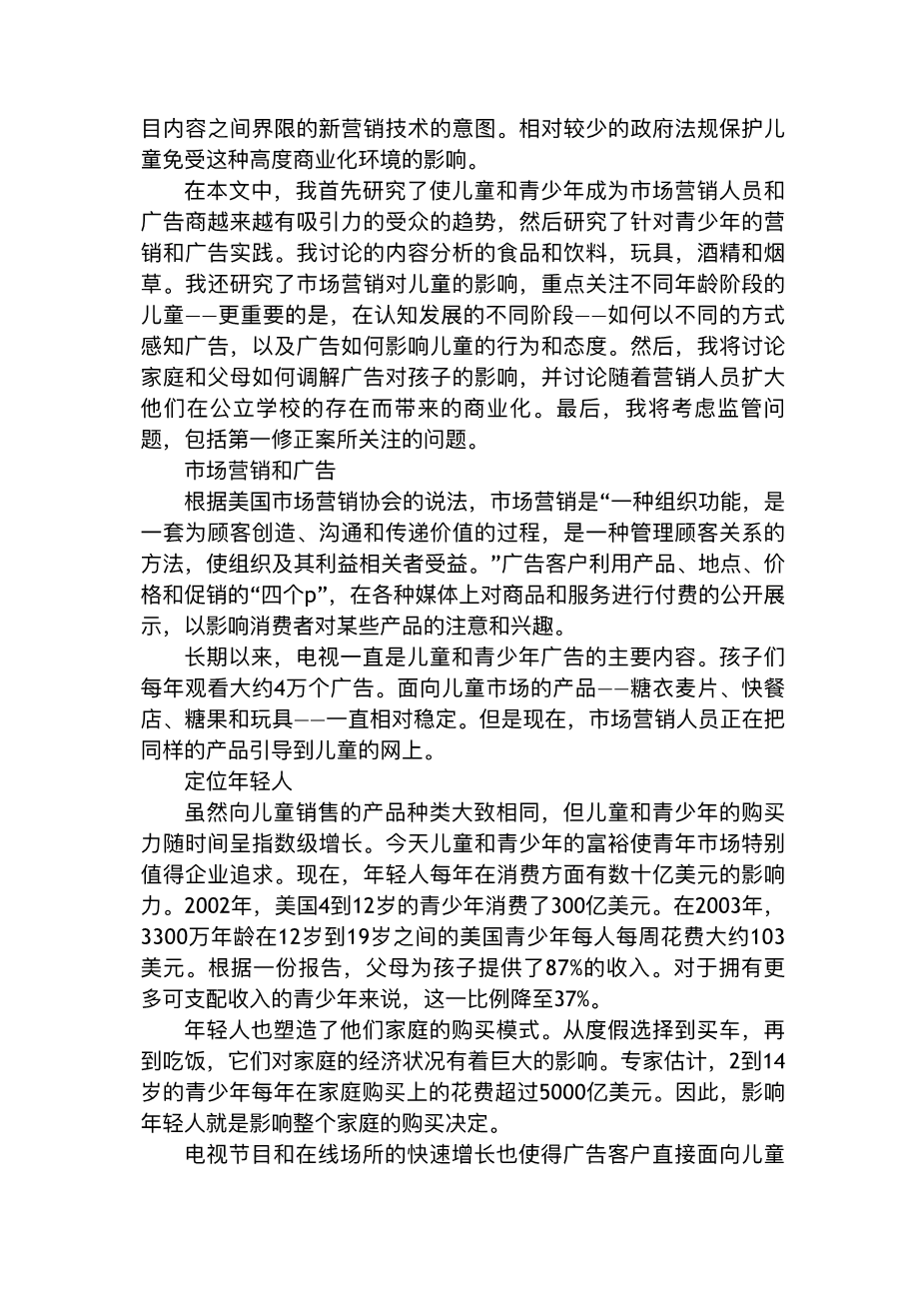Children as Consumers: Advertising and Marketing
Children as Consumers: Advertising and Marketing
Sandra L. Calvert
Summary
Marketing and advertising support the U.S. economy by promoting the sale of goods and services to consumers, both adults and children. Sandra Calvert addresses product marketing to children and shows that although marketers have targeted children for decades, two recent trends have increased their interest in child consumers. First, both the discretionary income of children and their power to influence parent purchases have increased over time. Second, as the enormous increase in the number of available television channels has led to smaller audiences for each channel, digital interactive technologies have simultaneously opened new routes to narrow cast to children, thereby creating a growing media space just for children and childrenrsquo;s products.
Calvert explains that paid advertising to children primarily involves television spots that feature toys and food products, most of which are high in fat and sugar and low in nutritional value.
Newer marketing approaches have led to online advertising and to so-called stealth marketing techniques, such as embedding products in the program content in films, online, and in video games.
All these marketing strategies, says Calvert, make children younger than eight especially vulner- able because they lack the cognitive skills to understand the persuasive intent of television and online advertisements. The new stealth techniques can also undermine the consumer defenses even of older children and adolescents.
Calvert explains that government regulations implemented by the Federal Communications Commission and the Federal Trade Commission provide some protection for children from advertising and marketing practices. Regulators exert more control over content on scarce television airwaves that belong to the public than over content on the more open online spaces. Overall, Calvert concludes, children live and grow up in a highly sophisticated marketing envi- ronment that influences their preferences and behaviors.
www.futureofchildren.org
Sandra L. Calvert is a professor and the chair of the Department of Psychology at Georgetown University. She is also the director of the Childrenrsquo;s Digital Media Center.
uring the 1920s, U.S. advertising leaders began to see that a consumer society would create larger markets for the surplus
D
fruits of mass production.1 Aware that people might not buy enough goods fast enough on their own, advertisers adopted a strategy of exploiting consumersrsquo; feelings of inadequacy and sought to market products as a means of alleviating consumersrsquo; negative self-image.
Their strategy succeeded beyond their great- est expectations.
Crucial to their success was the emergence and eventual dominance of television in U.S. homes.2 As the medium of television devel- oped, advertisers quickly realized that they could use it to bring products to the attention of mass audiences, both young and old, and thus deliver an enormous supply of children and adults to businesses.
Today, marketing and advertising permeate childrenrsquo;s daily lives. Many products marketed to children are not healthful and promote obesity. Younger children often do not understand the persuasive intent of advertise- ments, and even older children probably have difficulty understanding the intent of newer marketing techniques that blur the line between commercial and program content.
Relatively little government regulation protects children from this highly commer- cialized environment.
In this article, I first examine trends that have made children and youth an ever more attrac- tive audience for marketers and advertisers and then look at marketing and advertising practices directed toward youth. I discuss content analyses of foods and beverages, toys, and alcohol and tobacco. I also examine the effects of marketing on children, focusing
both on how children of different ages—and, more important, at different stages of cogni- tive development—perceive commercials in different ways and on how advertising affects childrenrsquo;s behaviors and attitudes. I turn then to how families and parents may mediate the impact of advertisements on their children and discuss the commercialization that results as marketers expand their presence in the public schools. I conclude by considering regulatory issues, including First Amendment concerns.
Marketing and Advertising According to the American Marketing Association, marketing is “an organizational function and a set of processes for creating, communicating, and delivering value to customers and for managing customer relationships in ways that benefit an organiza- tion and its stakeholders.”3 Using the “Four Ps” of marketing—product, place, price, and promotion—advertisers use paid public presentations of goods and services in a variety of media to influence consumersrsquo; attention to, and interest in, purchasing certain products.4
Television has long been the staple of adver- tising to children and youth.5 Children view approximately 40,000 advertisements each year.6 The products marketed to children— sugar-coated cereals, fast food restaurants, candy, and toys—have remained relatively constant over time.7 But marketers are now directing these same kinds of products to children online.8
Targeting Youth
Although the kinds of products marketed to children have remained much the same, the buying power of children and adolescents has increased exponentially over time.9 The affluence of todayrsquo;s children and adolescents
has made youth a market eminently worthy of pursuit by businesses. Youths now have influence over billions of dollars in spending each year.10 In 2002, U.S. four- to twelve-year- olds spe
全文共90254字,剩余内容已隐藏,支付完成后下载完整资料


英语原文共 20 页,剩余内容已隐藏,支付完成后下载完整资料
资料编号:[2393]
以上是毕业论文外文翻译,课题毕业论文、任务书、文献综述、开题报告、程序设计、图纸设计等资料可联系客服协助查找。
您可能感兴趣的文章
- 网络传播时代大学生媒介素养教育策略研究外文翻译资料
- 互联网营销趋势:纽约州马业网站和社交媒体使用现状分析 短标:互联网营销趋势外文翻译资料
- Facebook的竞争优势外文翻译资料
- 自我转型:通过社交媒体重新定位名人品牌 ——以伊丽莎白·吉尔伯特为例外文翻译资料
- 媒介融合和在不同层次的共同演化外文翻译资料
- 基于新媒体时代的国家软实力建构对策研究外文翻译资料
- 广告购买什么?关于意大利媒体股票上市公司的日常报道外文翻译资料
- 社交类客户端持续使用意愿研究:满意度、习惯和顾客价值的角度外文翻译资料
- 基于三阶段DEA模型的社会媒体对中国国家级风景名胜区运行效率的影响研究外文翻译资料
- 信息技术和线上社交网络管理效率分析:基于DEA模型的评估外文翻译资料


